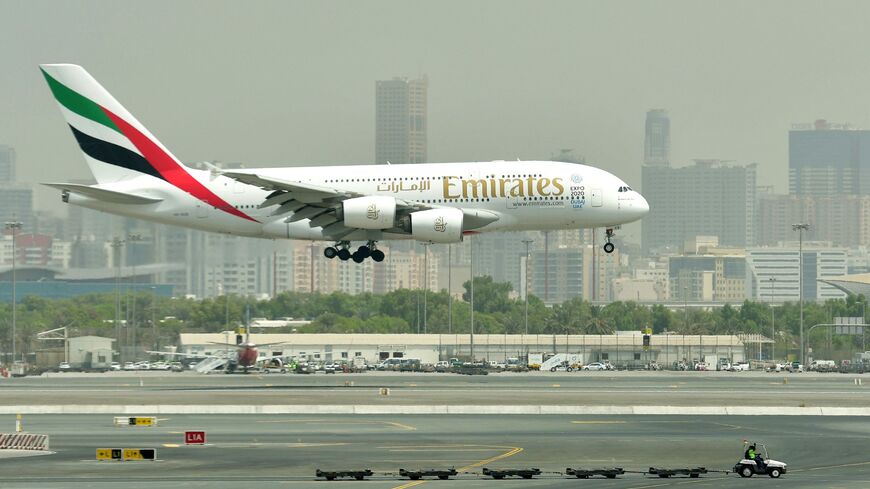Dubai’s $8.7 trillion economic development plan for the next 10 years — called D33 — that was announced earlier this month aims to cement the United Arab Emirate's (UAE) position as “the global city at the center of many emerging markets.”
The UAE, of which Dubai is part, looks to triple the number of containers handled annually in its port by 2032 and increase the number of Emirati-flagged ships and tankers to 2,000. The country’s flag-carrying airlines — Emirates and Etihad Airways — have started reintroducing their Airbus A380 fleet, the world’s largest passenger aircraft.
Neighboring countries are in the running as well. Saudi Arabia unveiled in November 2022 its plan for a massive aviation hub in Riyadh with six parallel runways designed to accommodate up to 120 million travelers by 2030 as part of a push to become a global logistics hub. Oman aims to leverage its location outside of the Strait of Hormuz, a narrow chokepoint rife with political conflict, to become a prime gateway to Gulf markets.
At first glance, Gulf countries’ appetite for the carbon-intensive transport and logistics industries collides with their declared ambition to be part of the global community’s response to climate change. The UAE pledged in October 2021 to reach net-zero carbon emissions by 2050; Bahrain, Saudi Arabia, Oman and Kuwait followed suit. Only Qatar has resisted it thus far.
But not just yet; countries still have time to expand their footprint in shipping and aviation before it could start undermining their net-zero pledges. Emissions from international aviation and maritime transport, aka international bunker fuel emissions, fall in the cracks. They are not counted in any country's national greenhouse gas inventories, unlike emissions from domestic flights and ships. Such accounting frameworks have kept emissions from critical components of the global economy — 90% of the world trade is transported by sea — out of countries’ climate plans, known as nationally determined contributions.
'Toothless regulators'
“Governments have decided to address emissions from international air traffic through a separate set of agreements”, William Raillant-Clark, a spokesperson at the International Civil Aviation Organization (ICAO), told Al-Monitor.
The United Nations aviation agency’s member states, including Gulf Cooperation Council (GCC) countries, agreed in October 2022 on an aspirational goal for international aviation of net-zero carbon emissions by 2050.
According to global airline industry body International Air Transport Association (IATA), adopting sustainable aviation fuel (SAF), a biofuel produced from sustainable feedstocks such as cooking oil, solid and forestry waste, will account for 65% of net zero by 2050. But the supply is insufficient. SAF production reached 300 million liters in 2022, compared to 450 billion liters required annually by mid-century. In January 2023, Emirati state-owned companies agreed with oil major BP to explore the production of SAF in the UAE; and Emirates operated a demonstration flight powered by 100% SAF in one of two engines.
Critics called SAF a “myth” that diverts attention from advancing aircraft electrification.
IATA estimates offsets and carbon capture to account for 19% of net zero by 2050. But carbon offsets used by major airlines today to market carbon neutral flights are likely to be “phantom credits” that are “worthless” in terms of carbon reductions, one study found. An alternative could be the mineralization of carbon that stores it in the form of rock. In January, Omani startup 44.01 signed a contract with Abu Dhabi National Oil Company (ADNOC) to mineralize carbon dioxide (CO2) within rock formations in Fujairah.
But the aviation industry has a poor track record in delivering on its promises. It failed to meet all but one of 50 of its own climate targets since 2000, environment campaigners found.
Saudi Arabia claimed its Riyadh planned aviation hub will be an “aerotropolis” powered by renewable energy with “sustainability at its core.” The Public Investment Fund, tasked with building King Salman International Airport, did not respond to a request for comment sent by Al-Monitor on whether the airport will push for decarbonizing international flights.
The kingdom’s planned second flag carrier — Riyadh International Airlines — is yet to specify how it intends to tackle emissions caused by its global operations. Gulf airlines Qatar Airways, Saudia, Emirates and Oman Air did not respond to requests for comment.
The International Maritime Organization (IMO), the United Nations shipping agency, adopted a strategy in 2018 to “cut annual greenhouse gas emissions from international shipping by at least half by 2050, compared with their level in 2008.” The nonbinding policy framework will be revised in 2023. IMO spokesperson Natasha Brown told Al-Monitor that member states, which include GCC countries, have already agreed to adopt a strengthened revised strategy.
Yet IMO asserts that CO2 emissions from international shipping “cannot be attributed to any particular national economy due to its global nature and complex operation.” Besides CO2, shipping is responsible for approximately 30% of global Nitrogen Oxides emissions, which are linked to thousands of premature deaths in coastal areas.
“Would you attribute international shipping emissions to the flag state of the ship? The country of the port where the ship loads cargo? Or shipowner? Or all of those?” Brown said.
What IMO encourages instead are national action plans to address international shipping emissions. As of January, no GCC states have submitted a national action plan to IMO.
Assaad Razzouk, a Singapore-based renewable energy entrepreneur who authored a book titled "Saving the Planet without the Bullshit" told Al-Monitor that aviation and shipping are overseen by “toothless regulators.” “ICAO's and IMO’s track records are pretty clear: They have done incredibly little while emissions continue to increase. In this context, I do not see how to be optimistic those emissions will be included in national inventories,” he said.
The writing might be on the wall, though. The European Union reached a deal in December 2022 to make airlines running flights within Europe pay for their carbon footprint. The scheme will not cover non-European flights’ emissions — covered by ICAO’s offsetting mechanism CORSIA — but EU negotiators could extend in 2026 the scheme’s scope to all departing flights if ICAO’s scheme “is not sufficiently aligned with the Paris Agreement.”
Gulf’s trump card: green hydrogen
Gulf countries are unlikely to lead innovation in the field of aircraft and container ship propulsion, given their limited research and development capacities in those sectors. Instead, the Gulf’s contribution to decarbonizing international shipping and aviation could be producing green fuel to enable the transition away from jet fuel and heavy fuel oil. The king of marine fuel has high sulfur content, which is linked to health problems and acid rain.
The opportunity for Gulf countries lies more specifically in the production of green hydrogen-based fuels like green hydrogen, green ammonia and green methanol. Such fuels are produced from renewable energy, like solar and wind, and the industry identified them as a credible alternative to power a large number of ships and aircraft in the coming decades, along with biofuels like sustainable aviation fuels.
Gulf countries are home to vast solar resources, which can position the region as a global hub for the production of green hydrogen-based fuels. Oman’s energy and minerals minister told Al-Monitor in January that the Sultanate is “embarking heavily” on green hydrogen. Saudi Arabia said it is building one of the world’s largest green hydrogen plants in Neom.
“The appetite for greener fuel alternatives is growing worldwide,” rating agency S&P Global wrote in a report. European plane maker Airbus said in November 2022 that it is developing a hydrogen-powered fuel cell engine to possibly equip its zero-emission aircraft scheduled to take to the skies by 2035. Saudi Arabia funded the preparatory phase of IMO CARES (Coordinated Actions to Reduce Emissions from Shipping), a program expected to be launched in 2023 to “accelerate demonstration of green technologies and their deployment.”
A.P. Moller Maersk, one of the world's largest container shipping companies, said in 2022 it plans to achieve net-zero emissions across its entire business and all scopes by 2040 and to transport 25% of all cargo using greener fuels, including green methanol. The Danish company ordered in 2021 eight vessels fitted with engines that can run on green methanol.
But not just yet; sales of low-sulphur marine fuels slumped 4.4% in 2022 at UAE’s Fujairah, the world’s third-largest hub for marine fuels, while sales of high-sulphur fuel oils jumped 12.3% from 2021 figures as a wide difference in prices prompted shippers to opt for the latter.
Beyond the role the Gulf region can play in producing and supplying greener fuel to ships, its container terminals face pressure to decarbonize operations. Emirati port operator DP World, whose flagship asset is Dubai’s Jebel Ali, the world’s eleventh-busiest port, intends to cut its CO2 emissions by 20% from 2021 levels over the next five years. It signed a partnership with Maersk in January to improve quayside productivity and ultimately cut fuel consumption.
Oil and gas industry’s 'garbage'
Razzouk believes there are “compelling arguments” for Gulf countries to channel more investments toward electrification since the region would “shoot itself in the foot” by expanding the global fossil fuel infrastructure, including oil-powered ships and aircraft. The United Nations acknowledged the role of burning fossil fuels in causing climate change and found that temperatures across the Gulf region rise faster than the world average.
But the transition to green hydrogen-based fuels would come at a cost for the Gulf oil and gas sector. Heavy fuel oil is a "waste product” from crude oil refining processes, Razzouk said in a podcast on the shipping industry. If vessel operators were not fueling ships with oil refiners’ “garbage,” the oil and gas industry would have to pay to “dispose of it safely,” he added.
A global shift to locally produced non-fossil fuel energy, including green hydrogen-based fuels, would still weigh on the Gulf’s shipping sector. Crude oil, natural gas, petroleum products and chemicals accounted in 2021 for 68% of all products loaded on ships in West Asia ports.
Gulf countries view climate risks, energy transition and fossil fuels as intrinsically linked. The UAE named ADNOC’s CEO Sultan Al Jaber as president of this year’s UN climate talks, set to begin in November in Dubai. He is also the UAE’s special envoy for climate change and is described as a “terrific environmentalist” by US Special Presidential Envoy for Climate John Kerry.
Climate action is “central” to the UAE’s development, Al Jaber said in his first speech as COP28 president. Razzouk acknowledged that Gulf countries have started to use their financial muscle — the region’s sovereign funds spent $89 billion on investments in 2022 — to become exporters of solar power, but “only to a certain extent.” “They could do 100 times more. Instead, they prioritize short-term interests at the expense of long-term ones,” he said.







